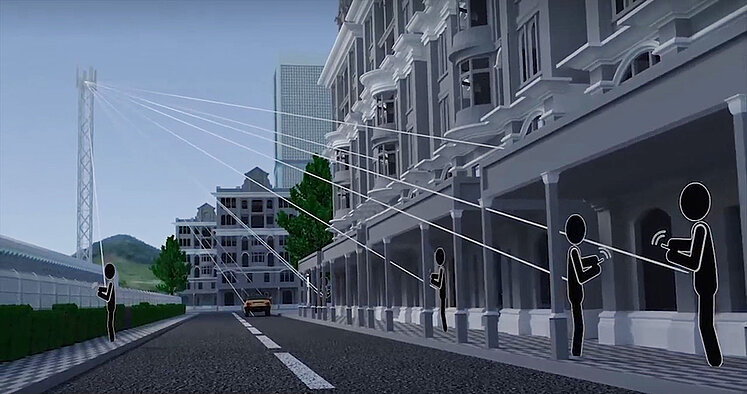
How does 5G Broadcast work?
5G Broadcast technology enables an unlimited number of users to be reached with a single data stream and without any loss of quality. 5G Broadcast is based on the 3GPP LTE-based 5G Terrestrial Broadcast broadcast standard (in short 5G Broadcast). It enables the distribution of linear media content via large radio cells with a radius of up to 60 kilometres. A single data stream is broadcast using a high-tower-high-power transmitter.
All mobile devices within the coverage area of this transmitter can receive the programmes distributed via this data stream. Since the signal is distributed only once to all receiving devices there is no excessive network utilization based on the number of receiving devices per cell and, therefore the quality of the programmes will not be reduced due to many devices..

The transmission standard was developed by 3GPP. 3GPP is an umbrella term for a number of standard development organisations which prepare protocols for mobile telecommunications. 3GPP standards are structured as Releases.
5G Broadcast was first introduced with Release 14 (Q2/2017) under the term "Further evolved Multimedia Broadcast Multicast Service" (FeMBMS), including special features for broadcasters (Enhanced TV (EnTV)).
FeMBMS was then further improvements with Release 16 (Q3/2020) were published as “LTE-based terrestrial 5G broadcasting”, also referred to as “5G Broadcast”.
Key broadcaster requirements
3GPP also defines broadcaster requirements to enable the distribution of linear and non-linear media services via 5G Broadcast. These include:
- Universal access: Geographical availability (e.g. national, regional, local) in accordance with the regulatory requirements.
- Free-to-air (FTA) access: Users can consume content without having to subscribe to the service provider or network operator.
- Defined Quality of Service (QoS): The Quality of Service is to be defined by the broadcasting stations themselves through service level agreements, e.g. availability of network transmissions, robustness, uptime, latency and reliability.
- No gatekeeping: Provision of PSM content for the public without excessively restricting the services offered, e.g. by blocking or filtering content, limiting access to services or the network infrastructure.
- Scalability: The defined Quality of Service must be independent of audience size for all users.
- Accessibility: Assistance ensured for people with disabilities (e.g. subtitles, audio descriptions and signing).
- Emergency situations: Ability to reach audiences in the event of a catastrophe or crisis and in exceptional circumstances.
- Costs: Nationwide content distribution and universal access should be affordable for PSM (including royalties for content) and consumers alike.
Key functions of 5G Broadcast
An aim of 5G Broadcast is to give broadcasters the opportunity to provide linear television for mobile devices as well as for conventional televisions using a single chipset. The standard also allows the dynamic use of residual capacity (if available) for the transmission of non-linear content. However, the dynamic use of residual capacities would require some changes on the regulatory side and further developments.
With 5G Broadcast it is possible to use the same media formats for media distribution (e.g. HLS, DASH) as for content delivery via the internet (OTT). This enables an easy way for seamless switching between distribution channels (e.g. 5G Broadcast and 5G Broadband) depending on Quality of Service and Quality of Experience parameters and results in the best media experience for the customers at all times. Furthermore, the linear content distributed with 5G Broadcast can easily be personalized by additional content distributed via internet and merged on user mobile devices.
Internet connection not required for operation
Another important key feature of FeMBMS is the reception of content without need of an internet connection. This Free-To-Air feature is important for public broadcasters which want to reach their customers without any restriction. However, adapted chipsets are required in mobile devices which enable the broadcast reception from HTHPs (high-tower high-power) with SDO (standalone downlink only) technology.
